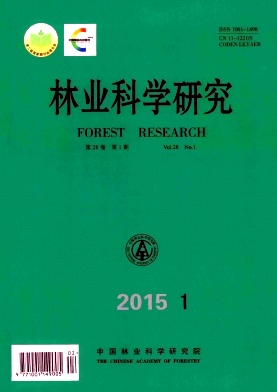|
[1]
|
唐旭利,周国逸.南亚热带典型森林演替类型粗死木质残体贮量及其对碳循环的潜在影响[J].植物生态学报, 2005, 29 (4): 559-568.
|
|
[2]
|
Christopher M, Christoph S, Clare K, et al. Coarse woody debris an the carbon balance of a north temperate forest[J].Forest Ecology and Management, 2007,244(1/3):60-67. |
|
[3]
|
Woldendorp G, Keenan R J. Coarse woody debris in Australian forest ecosystems a review[J]. Austral Ecology, 2005,30:834-843. |
|
[4]
|
Bigler C, Veblen T. Changes in litter and dead wood loads following tree death beneath subalpine conifer species in northern Colorado[J].Canadian Journal of Forest Research, 2011,41(2):331-340. |
|
[5]
|
Beets P N, Hood I A, Kimberley M O, et al. Coarse woody debris decay rates for seven indigenous tree species in the central North Island of New Zealand[J]. Forest Ecology and Management, 2008,256:548-557. |
|
[6]
|
何东进,何小娟,洪 伟,等.森林生态系统粗死木质残体的研究进展[J].林业科学研究,2009,22(5):715-721.
|
|
[7]
|
Harmon M E, Franklin J F, Swanson F J, et al. Ecology of coarse Wood debris in temperate ecosystems[J]. Advances in Ecological Researches, 1986,15:133-302. |
|
[8]
|
Schlegel B C, Donoso P J. Effects of forest type and stand structure on Coarse Woody Debris in old-growth rainforests in the Valdivian Andes, south-central Chile[J].Forest Ecology and Management, 2008,225:1906-1914. |
|
[9]
|
Brin A, Meredieu C, Piou D, et al. Changes in quantitative patterns of dead wood in maritime pine plantations over time[J]. Forest Ecology and Management, 2008,256:913-321. |
|
[10]
|
Pesonen A, Leino O, Maltamo M, et al. Comparison of field sampling methods for assessing coarse woody debris and use of airborne laser scanning as auxiliary information[J]. Forest Ecology and Management, 2009,257:1532-1541. |
|
[11]
|
何 帆,王得祥,张宋智,等.小陇山林区主要森林群落凋落物及死木质残体储量[J].应用与环境生物学报,2011,17(1):046-050.
|
|
[12]
|
王 飞,张秋良,王 冰,等.不同年龄杜香-兴安落叶松林粗木质残体贮量及特征[J].生态学杂志,2012,31(12):2981-2989.
|
|
[13]
|
安 云,丁国栋,高广磊,等.华北土石山区天然次生林枯立木数量特征与分布格局[J].水土保持通报,2012,32(4):246-250.
|
|
[14]
|
罗大庆,郭泉水,黄 界,等.西藏色季拉原始冷杉林死亡木特征研究[J].生态学报,2004,24(3): 635-639.
|
|
[15]
|
金光泽,刘志理,蔡慧颖,等.小兴安岭谷地云冷杉林粗木质残体的研究[J].自然资源学报,2009,24(7):1256-1266.
|
|
[16]
|
邓 云,张文富,邓晓保,等.西双版纳热带季节雨林粗木质物残体储量及其空间分布[J].生态学杂志,2012,31(2):261-270.
|
|
[17]
|
刘妍妍,金光泽.地形对小兴安岭阔叶红松(Pinus koraiensis)林粗木质残体分布的影响[J].生态学报,2009,29(3):1398-1407.
|
|
[18]
|
刘妍妍,金光泽.小兴安岭阔叶红松林粗木质残体基础特征[J].林业科学,2010,46(4):8-14.
|
|
[19]
|
刘志华,常 禹,胡远满,等.呼中林区与呼中自然保护区森林粗木质残体储量的比较[J].植物生态学报,2009,33(6):1075-1083.
|
|
[20]
|
张秋良,王 飞,李小梅,等.藓类-兴安落叶松林木质物残体贮量及组成[J].生态环境学报,2013,22(3):437-442.
|
|
[21]
|
Webster C R, Jenkins M A. Coarse woody debris dynamics in the southern Appalachians as affected by topographic position and anthropogenic disturbance history[J].Forest Ecology and Management, 2005,217:319-330. |
|
[22]
|
惠刚盈,Klausvon Gadow, 胡艳波,等.结构化森林经营[M].北京:中国林业出版社,2007:114-120.
|
|
[23]
|
韩铭哲.兴安落叶松自然更新格局和种群的生态对策[J].内蒙古林学院学报,1994,1(2):1-10.
|
|
[24]
|
玉 宝,乌吉斯古楞,王百田,等.大兴安岭兴安落叶松天然林林隙地被物变化特征研究[J].林业科学研究,2009,22(2):213-218.
|





 DownLoad:
DownLoad: